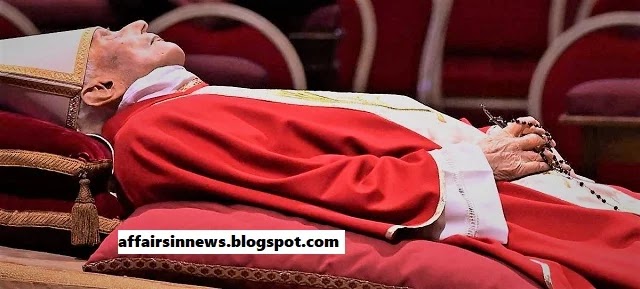Death of Benedict XVI: the difficult pontificate of the first pope emeritus
Pope Benedict XVI died on Saturday, December 31 at the age of 95. Joseph Ratzinger served in the Vatican for eight years. A pontificate marked by many crises.
Joseph Ratzinger was born on 16 April 1927 in Bavaria into a modest Catholic family. Like his Polish predecessor, Pope John Paul II, his youth was marked by the ordeal of Nazism and war. As a young seminarian, he was conscripted against his will into the Hitler Youth. He was ordained a priest at the age of 24 in June 1951, the same day as Georg, his older brother. He had visited his bedside in Germany two weeks before he died on July 1, 2020.
A brilliant professor of theology in Tübingen and Regensburg, Joseph Ratzinger participated as an expert in 1962 at the Second Vatican Council. He was only 35 years old and was then perceived as a reformer. But the events of May 1968, the crisis of protest within the Church and the liturgical reform of Vatican II profoundly changed his approach to modernity. In 1977, Pope Paul VI appointed him Archbishop of Munich. A position of short duration since in 1981, Pope John Paul II called him to Rome to head the powerful Congregation for the Doctrine of the Faith. An uncompromising guardian of Catholic Orthodoxy, he remained there for nearly a quarter of a century until the death of John Paul II on April 2, 2005.
Getting out of the culture of silence
On April 19, 2005, cardinals orphaned by the Polish pope elected his most faithful collaborator in the fourth round of voting. He took the name of Benedict, in memory of Benedict XV, defender of Europe and peace. He is 78 years old and accepts the heavy load out of a sense of duty "to guard the house". In addition, he is lucid about the storms that are coming. In 2001, revelations of sexual abuse perpetrated by priests in the Diocese of Boston opened a major crisis for the Church. A few days before his election, he had clearly spoken of the "defilements in the Church". A Church that resembles a "boat that takes on water", a barely veiled allusion to the crisis of pedophilia that his successor is still struggling to put an end to. Alone then in the turmoil of cascading revelations, Benedict XVI assumes the heavy bill of the culture of silence that has prevailed in the Church for decades. He is the first to talk about "zero tolerance". Similarly, he is the first pope to ask forgiveness for the faults committed by the Church during his trip to Australia in 2008 for World Youth Day (WYD).
To this major crisis is added a series of controversies. The most famous was that of Regensburg and its speech "Faith and Reason" in September 2006, in the famous German university. Benedict XVI raised the question of the link between violence and religion. The publication of the truncated version was received in the Muslim world as an equating of Islam with violence and sparked sharp tensions that he came to ease shortly after during his visit to the Blue Mosque in Istanbul. Similarly, an awkward statement about condoms on the plane that took him to Cameroon in 2009, his support for the beatification of the controversial Pope Pius XII, and the lifting of the excommunication of Bishop Williamson, a fundamentalist bishop of the priestly fraternity of St. Pius X, earned him harsh criticism from the media of which he was regularly targeted.
A misunderstood pope
During his pontificate, Benedict XVI had to deal with the Curia, its heaviness, dysfunctions and intrigues. Unlike his successor, Pope Francis, the reserved and timid Benedict XVI had neither the authority nor the temperament to impose himself and reform the curia. Indeed, the latter, with John Paul II, more globetrotter than manager, had done very well with the absences of the Polish pope. It is the "Vatileaks affair", leaked confidential documents revealing the existence of a large network of corruption, which defeated the resistance of the 85-year-old pope. In front of stunned cardinals, he announced his resignation, in Latin, on February 11, 2013. More than his many speeches, his encyclicals, including "Caritas in Veritate" on the injustices of globalization, his worried messages intended for a Western society in full de-Christianization, it is the announcement of his resignation on February 11, 2013 that remains the mark of his pontificate.
By voluntarily leaving an office that he could no longer bear, marked by the long agony of John Paul II, Benedict XVI, this pope seen as conservative, revolutionized the exercise of the papacy. Having become the first pope emeritus in the history of the Church, retired to the monastery "Mater Ecclesiae" in the heart of the Vatican gardens, Benedict XVI, who regularly met Pope Francis, continued to analyze to the end the evolution of our societies, which he saw threatened by their distance from God and anthropological changes, foremost among which homosexual marriage.
Retired in a life of prayer and study, he signed with Cardinal Sarah*, at the beginning of 2020, a book on the defense of the celibacy of priests whom he saw threatened. To restore the taste of the Christian faith, to rebuild the unity of Christians, these were the great objectives of the German pope, perhaps the last European pope, to be a misunderstood pope.
 |
| The body of the late Pope Emeritus Benedict XVI is on display in the chapel of the Mater Ecclesiae monastery where he lived mainly after his renunciation in 2013. |
The body of Pope Emeritus Benedict XVI on display to the faithful in Rome
the Vatican, the remains of Pope Benedict XVI are presented to the faithful on Monday morning. Thousands of them come to pay their last respects to the German pope, who died on Saturday morning, December 31. Four days of mourning will culminate until Thursday and the funeral of Benedict XVI celebrated by Pope Francis.
A long line of faithful formed at dawn to gather before the remains of Benedict XVI. The doors of St. Peter's Basilica, the largest church in the world, opened at 9am (8am GMT). Thousands of people are expected, under the lenses of many media. The prefecture of Rome has evoked the figure of 30,000 to 35,000 people per day until Wednesday, the last day when it will be possible to pay tribute to the German pope, says our correspondent at the Vatican, Eric Senanque.
Giorgia Meloni was among the first visitors. To cope with the influx of faithful and curious, in a Rome still very frequented by tourists, two flows will be able to enter the basilica simultaneously. After passing under a metal detector gate, worshippers and tourists enter through the central aisle into the church. In the basilica, visitors have only a few seconds to greet the body of Benedict XVI before leaving.
The security forces have also been strengthened: in addition to the Vatican gendarmerie and the Italian police, 500 civil protection volunteers have been mobilized, or about a thousand security agents. Roman public transport was also strengthened.
The last tribute of the faithful
Roberta, a resident of Rome, came to pay a last tribute to Benedict XVI: "This is a historic event, of very great importance. He has been a beloved pope, even if he has been challenged or sometimes misunderstood, and to see this popular devotion at this time is something that comforts.”
In the crowd that descends from the square, Yann, a young priest in cassock, from the diocese of Compiègne, in France, wanted to gather near the remains of the deceased pope. He came with some friends: "He is a pope who has marked us, I feel like the Benedict XVI generation. We promised to come for the funeral, unfortunately, we will not be able to be there on Thursday for the funeral, so we made an express round trip to go and meditate. Tomorrow, we will no longer be in Rome.”
Benedict XVI will join other popes in crypt
The crowd is expected to grow even larger for the funeral. A high mass will be celebrated at 9:30 a.m. by Pope Francis. These days of commemoration will end with the burial of the former pontiff on Thursday, January 5. Benedict XVI will join the other popes in the crypt under the altar of the basilica.
Joseph Ratzinger's remains had so far remained in the small private chapel of the monastery where he had lived since his renunciation in 2013, located in the heart of the Vatican gardens.
The Vatican on Sunday released the first photos of the body of the pope emeritus, lying on a catafalque, dressed in red — the color of papal mourning — and wearing a white mitre adorned with a golden strap, a rosary in his hands. A crucifix, a Christmas tree and a nativity scene are visible in the background.











0 Comments
Any question in your mind or a request you want me to fulfill, please don't hesitate, comment below or do email to me.
I will try whatever I can!